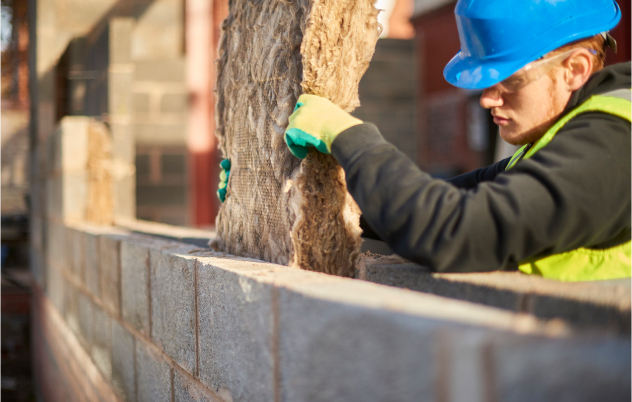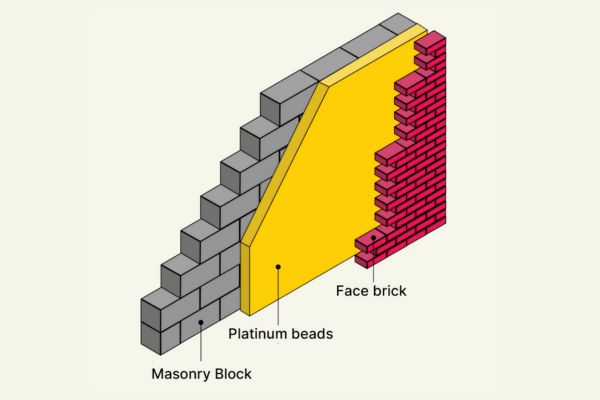Cavity Wall Insulation
Most homes built after 1920 have cavity walls. These houses have two layers of brickwork, seperated by a gap. This gap is called the cavity, and it’s responsible for heat loss. If your home doesn’t have cavity wall insulation, heat will pass through the air in the cavity and escape from the house.

What is Cavity Wall Insulation (CWI)?
Cavity Wall Insulation (CWI) is a method for slowing down heat loss through cavity walls. These are walls made up of an inner and outer layer, with a gap (cavity) between them.
The insulation itself comes in different forms, such as polystyrene beads, foam and wool.
In a home retrofit which involves CWI, the installer drills small holes into the outer wall, then pumps the insulation material into the cavity.

How does Cavity Wall Insulation work?
The installation process
Firstly, the installer drills small holes into the outer wall. Next, they pump the insulation into the cavity using specialist equipment. Finally, when the cavity is full, the installer re-fills the holes in the outer wall.
The insulation materials
By filling the cavity with insulation beads, foam, or wool, you stop heat from travelling across the walls. You can think of the insulation like a thermal vest between your skin and a jumper – an extra layer which keeps the heat in.
Cavity wall insulation materials have improved over time. If your insulation is old, you may need to replace it. Contact the installer and ask them to check the condition of the insulation. If the installer cannot help, check the contact details on the guarantee. The installer should have supplied this when they completed the work. Your home report often contains any work guarantees.
Types of CWI
There are several different kinds of materials for insulating cavity walls. These wall cavity fillers vary in cost, effectiveness and how environmentally friendly they are.
You may be familiar with mineral wool already – it’s commonly used in loft insulation and is sold in big yellow rolls.
Mineral wool is made in a similar way to candyfloss: a machine spins molten rock so that the fibres weave together.
The installer blows tufts of mineral wool into the cavity. These tufts knit together, forming an insulating layer.
Mineral wool is relatively cheap and effective. You can also recycle it.
The installer blows polystyrene beads into the cavity. Once the beads are inside the cavity, they expand and bond together, ensuring good coverage. Like blown mineral wool, polystyrene beads are relatively cheap whilst also being very effective.
The installer sprays polyurethane foam into the cavity. When the insulation foam dries, it solidifies. Whilst polyureathane foam is incredibly effective, it is also about twice the price of mineral wool or polystyrene bead insulation.
Pros and cons of Cavity Wall Insulation
- Relatively cheap form of wall insulation
- Reduced heat loss through walls should keep you warmer whilst lowering energy bills
- Some prep – such as clearing the cavity and repairing brickwork, may be required
- Special consideration needs to be taken with non-standard cavities or home construction
Cavity Wall Insulation: What to consider
If you’re thinking about getting cavity wall insulation, there are a few things to consider.
Is my home right for cavity wall insulation?
Firstly, you’ll need to check that your home has cavity walls. If your home is less than 100 years old, it’s likely to be the right type of construction.
Your Energy Performance Certificate will tell you what type of walls your home has. If they’re cavity, it will also tell you whether they are already insulated.
Another way to tell whether you have cavity walls is by looking at your home from the outside. Where possible, check the brickwork to see how the bricks have been laid. If all the bricks look the same length, then the wall is likely to have a cavity. If the bricks alternate between short and long, then the wall is unlikely to have a cavity.
Once you’ve established that your home has cavity walls, an installer would need to check that:
- The cavity is at least 50mm wide
- The wall is in good condition
- There’s no rubble in the cavity
- The walls aren’t exposed to driving rain
Make sure the work is carried out by a trusted installer
As with any kind of retrofit work, it’s important to go with a trusted installer. This gives you the best chance of a high quality install, as well as safeguards should any issues arise.
For CWI, look for installers who are members of the National Insulation Association (NIA), Cavity Insulation Guarantee Agency (CIGA), or other recognised trade associations or guarantee scheme.
Cost of Cavity Wall Insulation
Cavity wall insulation typically costs around £20 per m2, making it the most cost-effective kind of wall insulation. The exact cost will vary depending on the insulation materials.
Regardless of the size of your home, cavity wall insulation should pay for itself within five years. This is because the amount you’ll save on your energy bills over five years should equal the cost of the insulation.
It’s possible to receive grant funding for cavity wall insulation. For more information, see our Grant funding for cavity wall insulation section below.
Funding for Cavity Wall Insulation
Grant funding for cavity wall insulation is available through our Home Energy Scotland service.
The Home Energy Scotland Grant offers homeowners up to £1,500 towards cavity wall insulation. On top of that, £500 is available through an optional interest-free loan.
To apply for Home Energy Scotland Grant funding, simply call their freephone number on 0808 808 2282 to speak to an advisor.
Cavity Wall Insulation FAQs
Yes, as long as all the flats above and below yours get the insulation as well. The cavity runs the entire height of your block, so you can’t fill just one section of it. The installer pumps the insulaton in at the top of the building, so it fills up from the bottom. You can think of it like pouring marbles into a pint glass. It’s impossible to just fill the top third or middle third of the glass – you have to fill the entire thing from the bottom.
There has been a lot of misinformation about cavity wall insulation causing damp. Cavity wall insulation in itself is very unlikely to result in damp. The vast majority of issues are due to bad practice on the part of installers.
This is why it’s important to always use an accredited insulation company. A responsible installer will make sure:
- Not to block any ventilation (such as vents and airbricks)
- To address any pre-existing issues with damp before installing any insulation
- The cavity is free of rubble or debris
- The exterior walls are in good condition
- To check if your property receives high levels of wind-driven rain.
Cavity wall insulation is installed from the outside, so there’s no need for installers to enter your home.
Depending on the height of your home, the installer may need to use scaffolding. This will definitely be the case if you live in a flat.
The installer will drill a number of holes into the outer wall, then pump in the insulation. There will be noise from both the drilling and the pump. Afterwards, the installer re-fills the holes.

Changeworks delivers Home Energy Scotland in the south east and Highlands and Islands on behalf of the Scottish Government and Energy Saving Trust.
As well as providing free, impartial expert advice to thousands of people every month to help them to keep warm in their homes for less, they identify funding opportunities for households seeking to install energy efficiency measures.
For more information, give Home Energy Scotland a call on 0808 808 2282 or email and the team will be happy to help you.